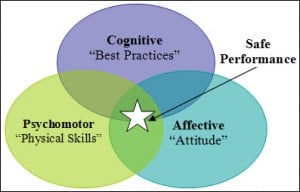Are Your Safety Meetings Working, or Do Your Employees Practice Their Mistakes?
Accidents do not always occur when one behaves in an unsafe manner. However if one continues an unsafe behavior “practicing mistakes,” the probability will dramatically increase, resulting in an accident.
Most organizations direct supervisors to conduct periodic safety meetings with their staff in hopes of increasing the level of safety awareness throughout the organization. While the objective has merit, the supervisors are typically less than enthusiastic for the responsibility. They view the safety meeting task as just something else added to their ever-growing list of responsibilities – something they “have” to do rather than something that may greatly increase the safety of their workplace, and therefore, the company’s bottom line.
In the absence of any training in how to conduct a safety meeting, the lack of both enthusiasm and training is quite transparent to the staff participating in the meeting. Safety becomes something that the staff views as needed to be checked off the supervisor’s list. When these types of undirected safety meetings are audited, one quickly sees the underlying objective is not to share a concept and create a learning experience, but to get staff’s signature on the safety meeting log sheet.
Click Link to Access Free PDF Download
“4-Step Sequence For Effective Employee Screening, Hiring, & Placement”
These poorly-focused meetings are actually communicating to the staff that safety is not truly a priority. On the other hand when provided some very simple and focused information in a short lesson-plan style, the task of coming up with a meeting topic is removed from the supervisor’s to-do list. This is a win-win on many levels, providing multiple benefits:
1. Supervisors merely have to follow an outline of talking points.
2. The meetings become “Single Concept” and focused, not rambling time killers.
3. The opportunity for non-safety issues to enter into the meeting is eliminated.
To get even more mileage from topic-focused meetings it is beneficial to reinforce the subject with visual support materials put up in common areas shared by staff. Many individuals are more visual learners than auditory, so illustrations in the form of posters and calendars are excellent tools to further the safety message. It’s important to make sure those visual support materials are on message, though, Typical “Safety Posters” may have clever slogans, but they address a too-general audience and the posters tend to stay up way too long. They become part of the wallpaper and are no longer seen by staff.
Visual support materials designed specifically for the particular people and work environment being targeted, though, are even more effective. These materials are relevant, so people pay attention and really get the message, and everyone benefits from a healthier, safer workplace.
Safe Performance is the interlocking of three distinct learning domains:
1. Cognitive – learning the correct procedure “best practices”
2. Affective – growth in feelings or emotional areas (attitude)
3. Psychomotor – physical skills

Without all these learning domains addressed, ultimate Safe Performance will not be achieved. In most individuals, the Affective is the most difficult to impact. Our built-in defense mechanisms tell us accidents happen to others, not to ourselves.
Cognitive is fairly straight forward – you either know the rules or best practices or you do not. Psychomotor may require developing specific physical skills, like learning to fly a plane or operate a fork lift. Once understanding the rules and mastering the skills, we must then put them together with the proper ATTITUDE.
Attitudes are best shaped and maintained through short learning episodes of small pieces of targeted information. Just as one-minute television commercials tend to change consumer behavior and get us to spend our hard earned dollars, short lessons reinforced with smart, demographically-targeted visuals are powerful tools in shaping attitudes toward safety. Just like the Nike commercial, “there is no finish line.
Be proactive about safety. Provide the tools to truly establish and maintain a corporate safety culture.
Author: W. Kent Jessee Ed.D. Dr. Jessee and his team have been helping companies improve the safety culture for 30 years. Clients include McDonalds, Chevron, Verizon, Safeway and many other recognized organizations desiring to MAKE GOOD PROGRAMS EVEN BETTER! http://www.wkjessee.com/
WC Calculator: www.reduceyourworkerscomp.com/calculator.php
TD Calculator:www.ReduceYourWorkersComp.com/transitional-duty-cost-calculator.php
Do not use this information without independent verification. All state laws vary.
©2008 Amaxx Risk Solutions, Inc. All rights reserved under International Copyright Law.















